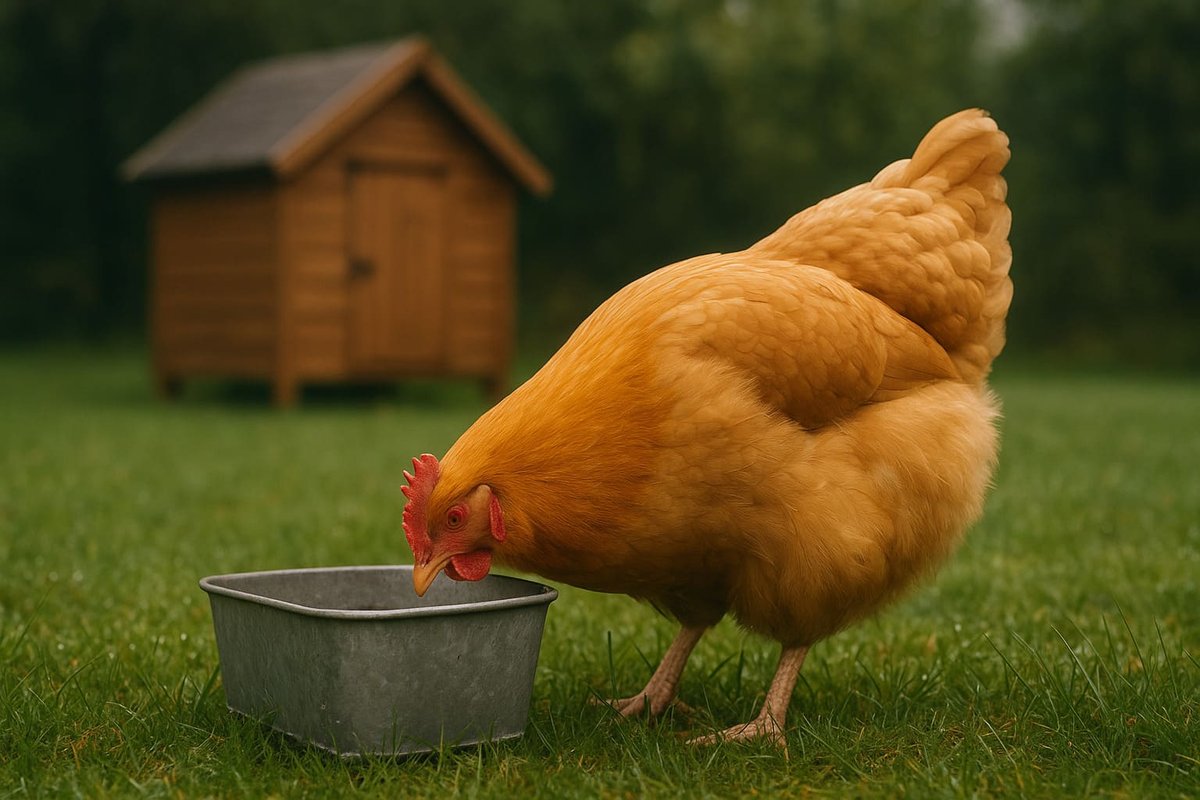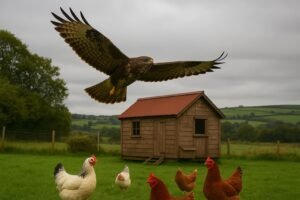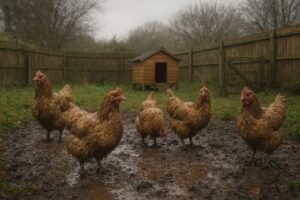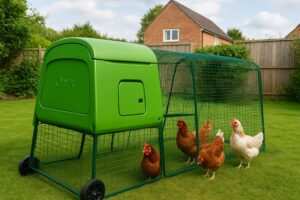As a UK backyard chicken owner, you know the simple joy of collecting fresh eggs. But getting those perfect, golden-yolk eggs starts with one crucial thing: the right feed. Walking into a feed store or browsing online can be overwhelming. Pellets, crumbs, growers, layers… what does it all mean? From my own rainy garden in Yorkshire, where I’ve raised a happy flock of eight hens, I’ve learned that choosing the right feed can make all the difference to their health and happiness.
If you’re looking for the best nutrition for your flock, you’ve come to the right place. This guide is your one-stop-shop for understanding poultry feed in the UK. We’ll explore A Guide to the Best UK Poultry Feed Brands (Allen & Page, BOCM, Small Holder Range), breaking down what they offer. We’ll cover everything from Allen and Page feeds to Small Holder Range Super Mixed Corn. More importantly, we’ll answer those key questions every chicken keeper asks, like ‘What are poultry pellets?’ and ‘Can chickens eat too much grower feed?’ Whether you’re after the best organic chicken feed UK has to offer or just need a reliable, budget-friendly option, we’ve got you covered.
What Are Poultry Pellets? A Basics Guide for UK Backyard Chickens
So, what exactly are poultry pellets? Think of them as a complete, balanced meal for your chickens, all packed into a neat, easy-to-eat shape. They are essentially poultry mash—a mix of grains, proteins, vitamins, and minerals—that has been heat-treated and compressed into small, dense pellets. This process not only makes the feed easier to handle but also helps to kill off any potential pathogens.
Mash vs. Pellets vs. Crumbles: What’s the Difference?
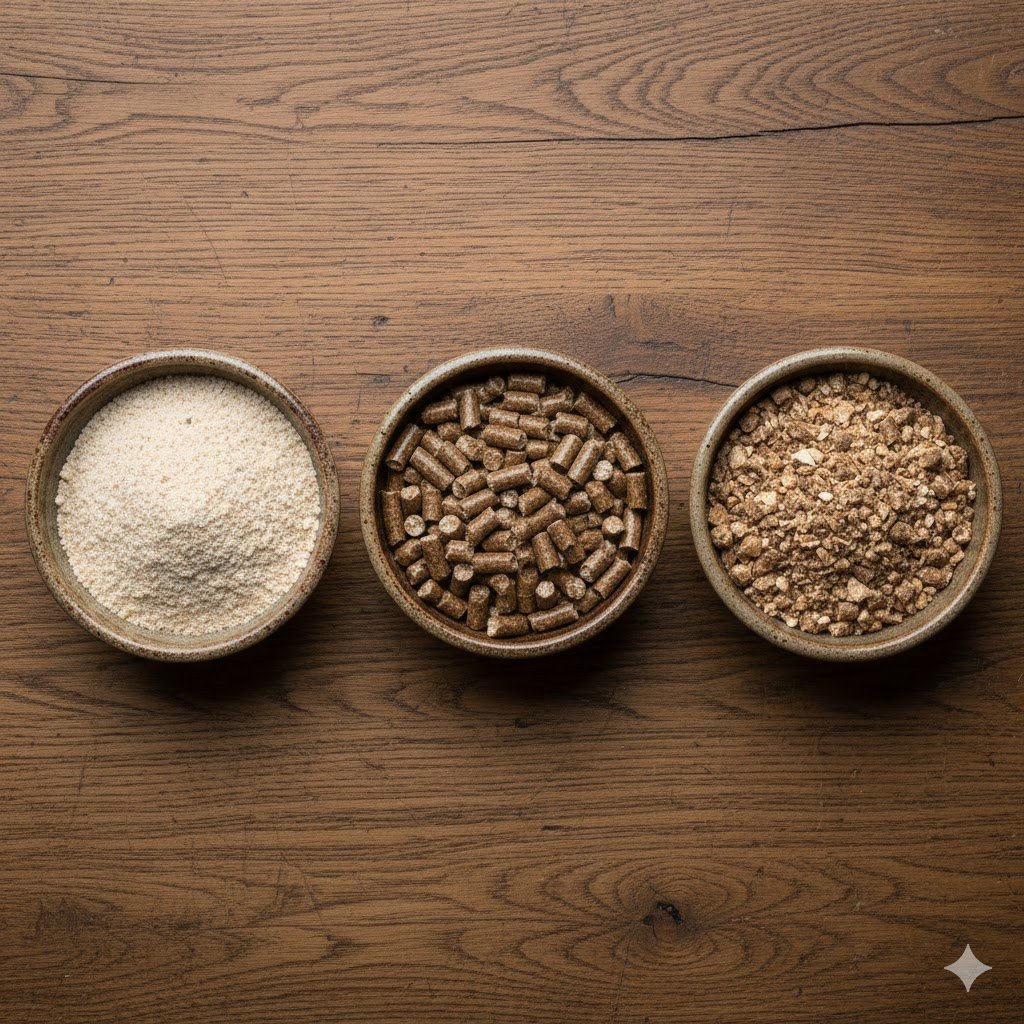
You’ll often see feed sold in three forms. Understanding the difference is key to choosing the right one for your flock’s age and needs.
- Mash: This is the unprocessed version of chicken feed. It’s a fine, ground-up mixture of all the ingredients. While nutritious, it can be messy, and chickens are notorious for picking out their favourite bits (usually the corn!) and leaving the rest. This is known as selective feeding.
- Pellets: To solve the problem of selective feeding, mash is steam-pressed into pellets. Each pellet is a complete nutritional nugget, ensuring your hens get a balanced diet in every single peck.
- Crumbles: These are simply pellets that have been broken up into smaller, more manageable pieces. Crumbles are perfect for young chicks who are too small to eat full-sized pellets but have outgrown the fine texture of chick crumb.
For a broader overview of what to feed your flock and what to avoid, see our comprehensive guide to feeding chickens.
Benefits of Pellets for UK Flocks
The main benefit of pellets is that they ensure your hens get a balanced diet. Unlike mash, where a picky hen might only eat the bits she likes, poultry pellets contain all the good stuff in one bite. This dramatically reduces selective feeding and minimises waste, which is a big plus for any backyard hen nutrition guide.
In the UK, pellets also have a practical advantage. Our damp climate can cause mash to spoil or clump together. Pellets are more robust and store better in airtight containers, staying fresh for longer. Brands like Allen & Page ensure their pellets are made with non-GM ingredients, giving you peace of mind. For backyard hens, especially who might be a bit fussy, poultry pellets are a simple and effective way to deliver consistent nutrition.
How to Store Your Feed Correctly in the UK
Proper storage is crucial to keep your feed fresh and safe. In our often-damp UK climate, feed can quickly spoil or attract pests.
- Keep it Dry: Store your feed sacks in a cool, dry place off the floor. A shed or garage is ideal.
- Use Airtight Containers: Once opened, transfer the feed into a galvanised metal dustbin or a food-grade plastic container with a secure lid. This keeps out moisture and prevents rats and mice from helping themselves.
- Check the Date: Always check the “best before” date on the bag. Feed loses its nutritional value over time, especially the vitamins.
With the basics of feed types and storage covered, let’s focus on the specific feed your young, growing chickens need to thrive: growers pellets.
What Are Growers Pellets For? Essential Info for Young UK Chickens
Once your chicks have graduated from their initial chick crumb, the next stage is growers pellets. So, what are growers pellets for? They are specifically designed for pullets—that’s the term for young hens—typically between the ages of 6 and 18 weeks. This is a critical growth phase where they are developing their bones, muscles, and organs, but aren’t quite ready to start laying eggs.
The Growth Timeline: From Chick to Pullet
A chicken’s nutritional needs change rapidly. Here’s a quick timeline:
- 0-6 Weeks: Chicks need high-protein (19-22%) Chick Crumb for rapid growth. Some chick crumbs are medicated with an anti-coccidiostat to prevent coccidiosis, a common and deadly gut parasite in chicks. If your chicks have been vaccinated against this, use unmedicated feed. Vaccination is a common practice in the UK for backyard chicks, so it’s always worth checking with the hatchery or breeder.
- 6-18 Weeks: Pullets transition to Growers Pellets with slightly lower protein (16-18%) for steady, healthy development.
- 18+ Weeks: Once they start laying, they move onto Layers Pellets, which are lower in protein but high in calcium.
For the best grower feed for pullets UK, look for brands like BOCM or Allen & Page with added vitamins to support feathering in our variable weather.
Why Protein and Calcium Levels Matter in Growers Feed
According to 2025 guidance from poultry experts like Omlet and DEFRA, growers pellets contain around 16-18% protein. This level is crucial for developing strong muscles, healthy organs, and good feathering. But just as important is what they don’t contain: high levels of calcium. Too much calcium at this young age can strain their kidneys and cause health problems down the line. Growers pellets ensure they build a strong frame without pushing them into laying eggs too early, which can cause stress on their young bodies. When raising a flock, it’s a good idea to have them checked over by a vet registered with the APHA (Animal and Plant Health Agency) to ensure they are developing correctly.
Transitioning to Growers Pellets Smoothly
To avoid digestive upset, it’s best to transition your young birds gradually. Over a week, mix their old feed with the new growers pellets, slowly increasing the proportion of the new feed each day. For example:
- Days 1-2: 75% chick crumb, 25% growers pellets.
- Days 3-4: 50% chick crumb, 50% growers pellets.
- Days 5-6: 25% chick crumb, 75% growers pellets.
- Day 7: 100% growers pellets.
Following the best feeding schedule for backyard chickens can help make these transitions even smoother.
Ensuring your young flock gets the right food is crucial for their development, but it’s also important not to overdo it. Let’s look at the risks of overfeeding and how to get the portions just right.
Can Chickens Eat Too Much Grower Feed? Risks and Tips for UK Owners
This is a common worry for new chicken keepers. Can chickens eat too much grower feed? Generally, chickens are pretty good at self-regulating their food intake. However, it’s not impossible for them to overeat, especially if they are kept in a smaller run without much to do.
Spotting the Signs of Overfeeding
The main risks of overfeeding backyard chickens in the UK are obesity and potential nutrient imbalances. A chubby chicken is more prone to health issues. Here are a few signs to watch for:
- Excessive Weight: Gently pick up your pullet. Her keel bone (breastbone) should feel defined but not sharp. If you can’t feel it easily, she may be overweight.
- Lethargy: Overfed birds may be less active and less interested in foraging.
- Reduced Foraging: A healthy pullet will spend her day scratching and exploring. If she just sits by the feeder, it could be a sign of over-consumption.
Practical Tips for Perfect Portions in UK Backyards
While growers pellets are balanced for growth, a sedentary pullet in a small UK garden might consume more than she needs.
- Monitor Intake: Most experts recommend providing around 100-150g of feed per hen per day, but it’s best to monitor your flock. If they are clearing the feeder in minutes, you might be underfeeding. If food is left for days, you could be overfeeding.
- Use a Good Feeder: A treadle feeder can prevent waste and stop pests like rats and pigeons from stealing food.
- Encourage Foraging: As I mentioned, scattering feed is great. In my experience, scattering some Smallholder Range Super Mixed Corn in the afternoon gets them moving and satisfies their natural instincts. It’s also vital to ensure enough space for your chickens to forage, as this activity prevents boredom and overeating.
- Provide Greens: Mixing in some chopped greens (like kale or spinach) can also bulk out their diet without adding excess calories. For another way to boost nutrition and digestion, you can try fermenting chicken feed for better health.
- Constant Fresh Water: Always provide clean, fresh water. Chickens drink about twice as much as they eat, and proper hydration is essential for digestion and overall health.
Getting the quantity right is one part of the puzzle, but feeding the correct type of pellet is even more critical as your birds mature. Now, we’ll explore the vital differences between growers and layers pellets.
What’s the Difference Between Growers Pellets and Layers Pellets? A Clear Comparison for UK Backyard Chickens
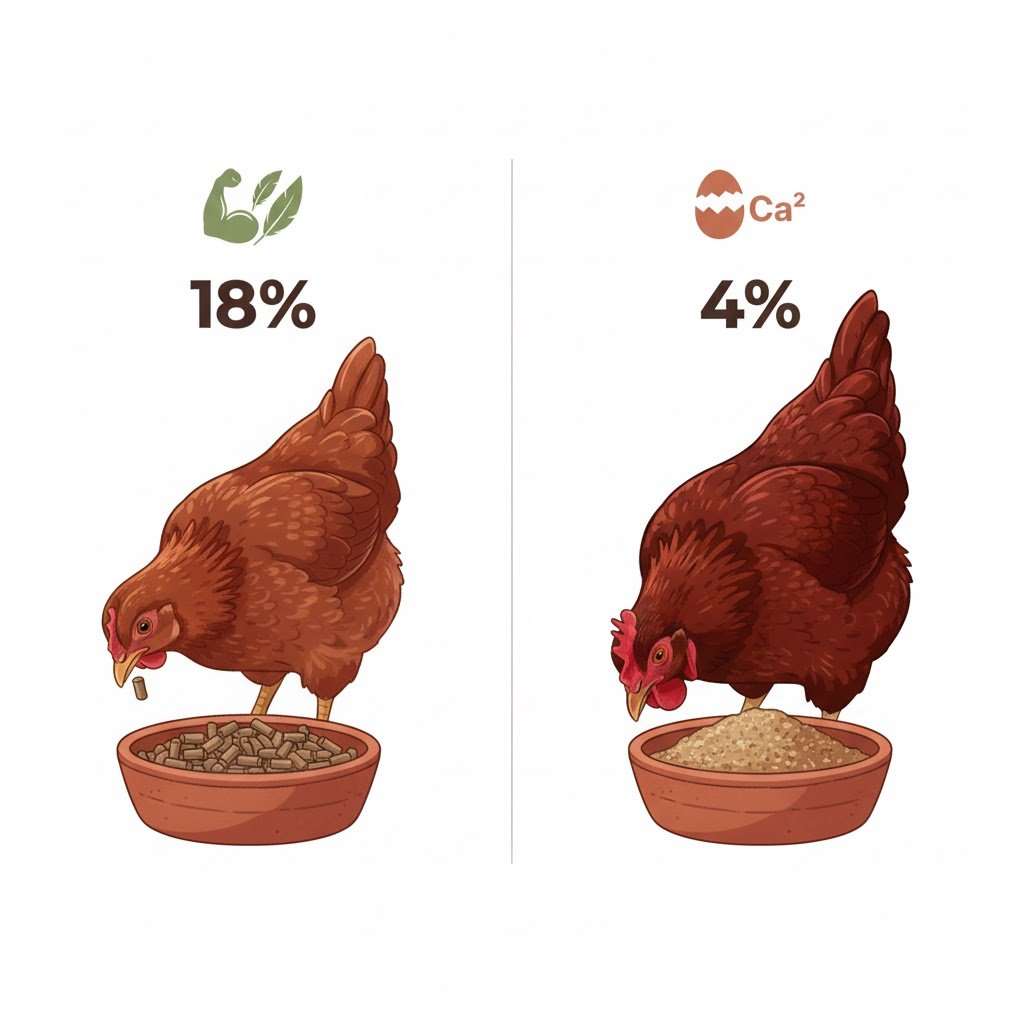
Understanding the distinction between these two feed types is vital for a healthy, productive flock. Using the wrong one at the wrong time can lead to problems. The discussion around calcium in layers vs growers feed is critical for any chicken keeper. Here’s a clear breakdown.
| Aspect | Growers Pellets | Layers Pellets |
|---|---|---|
| Age Group | 6-18 weeks (growth phase) | 18+ weeks (laying hens) |
| Protein Content | 16-18% (for muscle/frame building) | 15-16% (for maintenance & egg production) |
| Calcium Content | Low (1-2%, to avoid kidney strain) | High (3-4%, essential for strong eggshells) |
| UK Example | BOCM Poultry Growers Pellets | Allen and Page Layers Pellets 5kg |
| Risks if Fed Incorrectly | Layers on growers feed: Weak, soft shells. | Growers on layers feed: Potential kidney damage and growth issues. |
For a more in-depth look at this topic, see Omlet’s detailed growers vs. layers pellets guide.
The Crucial Role of Calcium in Layers Pellets
Once a hen starts laying, her calcium requirement skyrockets. It takes a huge amount of calcium to produce a strong eggshell every 24-26 hours. Layers pellets are formulated with 3-4% calcium to meet this demand. A lack of calcium can lead to thin-shelled or soft-shelled eggs, and in severe cases, the hen may start to draw calcium from her own bones, leading to osteoporosis. For this reason, you should always provide a separate bowl of crushed oyster shell grit for your laying hens to take as they need, as advised in the RSPCA chicken feeding guide. To understand this topic fully, explore our ultimate guide to calcium for chickens.
When and How to Switch to Layers Pellets
As the 2025 NesTera guide points out, the transition is key. You should switch your pullets from growers pellets to layers pellets around 18 weeks of age, or when you see the very first egg. Look for signs of “point-of-lay”:
- The Submissive Squat: When you approach, she may squat down in a submissive posture.
- Colour Change: Her comb and wattles will become a deeper, brighter red.
- Exploring Nest Boxes: She’ll start showing interest in the nesting areas.
Use the same gradual, 7-day transition method described earlier to switch from growers to layers pellets.
Knowing the difference is key, but the next step is choosing a brand. Let’s break down the biggest names on the UK market to help you find the perfect match for your flock.
A Guide to the Best UK Poultry Feed Brands (Allen & Page, BOCM, Small Holder Range)
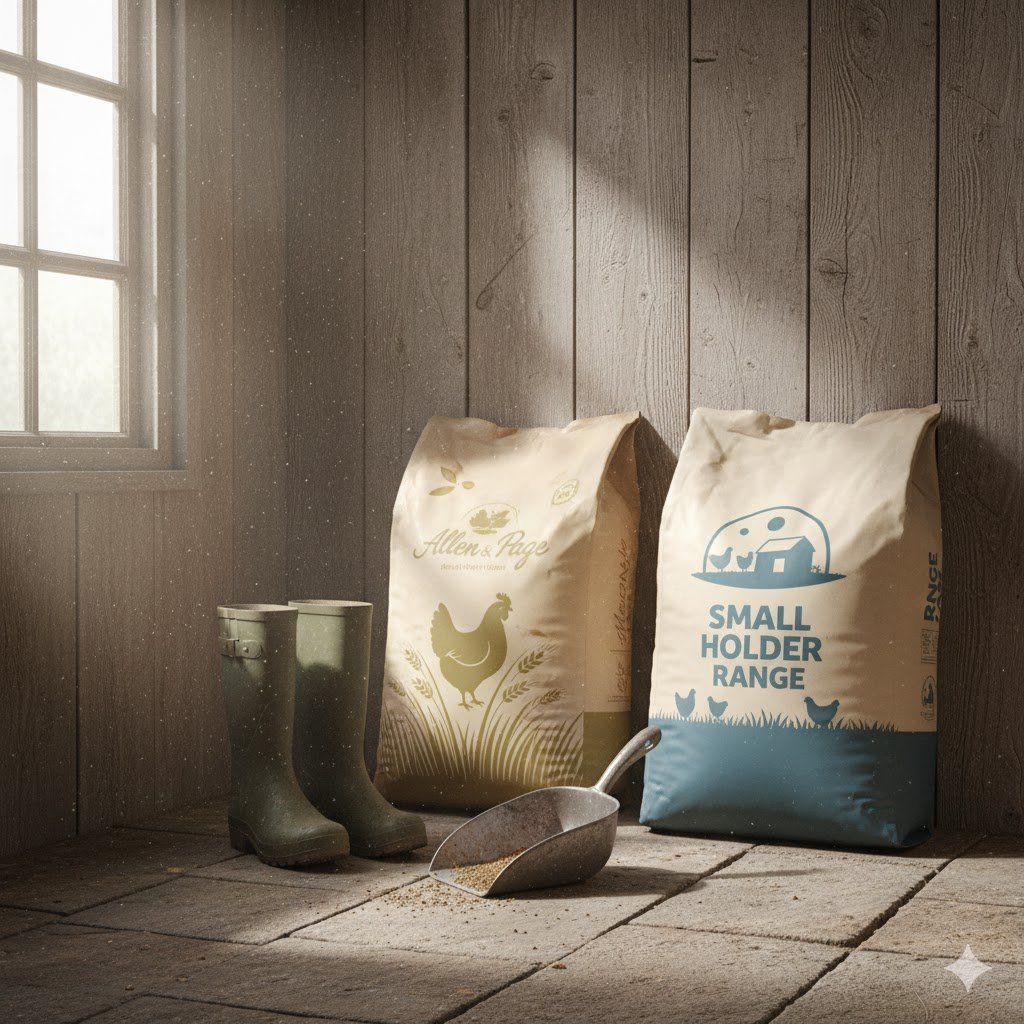
Now, let’s look into the brands you’ll find in most UK feed suppliers. Each has its own strengths, catering to different philosophies and budgets.
| Product | Brand | Size | Price (2025 Approx.) | Best For | Key Benefit (UK-Specific) |
|---|---|---|---|---|---|
| Allen and Page Layers Pellets | Allen & Page | 5kg | £12 | Small flocks | Omega-3 for golden yolks in rainy climates |
| Allen and Page Chick Crumb | Allen & Page | 20kg | £20 | Chicks 0-8 weeks | Prebiotics, drug-free; mix for damp starts |
| Allen & Page Organic Layers Pellets | Allen & Page | 20kg | £25 | Organic seekers | 100% natural, RSPCA-aligned for welfare |
| Smallholder Layers Pellets | Small Holder Range | 20kg | £18 | Rescued/free-range hens | No additives, Veggie-approved; helps feathering |
| Smallholder Range Super Mixed Corn | Small Holder Range | 5kg | £10 | Treats | Wheat/maize mix with grit; 10% diet max to avoid obesity |
| Allen & Page Care & Gain | Allen & Page | Varies | £15+ | Underweight birds | High-fibre herbs like mint; recovery for ex-battery hens |
| BOCM Poultry Growers Pellets | BOCM | 20kg | £15 | Budget pullets | 16-18% protein, non-GM basics; great for larger UK flocks |
To help you choose, here’s a quick comparison table:
| Feature | Allen & Page | BOCM Pauls | Small Holder Range |
|---|---|---|---|
| Key Selling Point | Premium, natural, organic options, Non-GM | Value for money, reliable, widely available | Natural, ethical, great for rescued hens |
| Price Range (20kg Layers) | £18 – £25 (Premium) | ~£15 (Budget-friendly) | ~£18 (Mid-range) |
| Target Audience | Health-conscious, organic keepers, small flocks | Budget-conscious keepers, larger flocks | Hobby keepers, rescue hen owners |
| Best For… | Vibrant yolks, overall hen condition | Consistent laying on a budget | Natural feeding & supporting rescued birds |
| Key Product Example | Allen & Page Organic Layers Pellets | BOCM Pauls Layers Pellets | Smallholder Layers Pellets |
Allen & Page: The Premium Natural Choice
Allen & Page is a family-run mill based in Norfolk, renowned for its natural, high-quality, and often organic feeds. Their core philosophy revolves around creating feeds that are as close to nature as possible, and they have been a champion of Non-GM ingredients since before it became a mainstream concern. This makes them a top choice for those seeking premium nutrition and a natural poultry pellets for laying hens option.
User & Forum Perspectives: Across UK poultry forums like The Poultry Keeper and backyard chicken Facebook groups, Allen & Page is consistently praised for the visible impact on hen health. Users frequently report a noticeable difference in egg yolk colour, describing them as much richer and more golden—a key benefit of their inclusion of omega-3 oils.
A common comment from 2025 forum posts is, “You can tell when they’re on A&P, their feathers get a wonderful sheen.” The main drawback cited by users is the price; it is a premium product, and keepers with larger flocks sometimes find the cost prohibitive compared to other brands. Their feeds are also completely drug-free, and their principles are often aligned with RSPCA guidelines, which is a major plus for welfare-conscious keepers.
Key Products & Details:
- Allen and Page Layers Pellets (5kg/20kg): Their flagship product. The 5kg bag (around £12) is perfect for small flocks of 2-6 hens, ensuring freshness.
- Allen & Page Organic Layers Pellets 20kg: This is their top-tier, 100% organic option (around £25), ideal for those wanting a fully organic system. It’s a favourite among keepers aiming for the best possible golden yolk chicken feed.
- Allen & Page Care & Gain: A specialist conditioning feed. Forum users who have taken on rescue hens often recommend this for helping underweight birds recover, praising its high-fibre, high-oil formula and the inclusion of herbs like mint and nettle to boost appetite.
BOCM Pauls: The Reliable & Affordable Workhorse
BOCM Pauls is a major UK supplier and can be considered the reliable workhorse of the poultry feed world. They focus on producing scientifically formulated, balanced, and affordable feeds that meet all DEFRA standards. For keepers who are practical, on a budget, or have a larger number of birds to feed, BOCM is often the go-to brand.
User & Forum Perspectives: In online discussions comparing brands, BOCM is lauded for its value for money. A 20kg bag of their layers pellets typically costs around £15, significantly cheaper than the premium organic brands. Users report consistent quality and good general health in their flocks. A frequent sentiment is, “It’s a good, no-nonsense feed that gets the job done.” However, some users note that the pellets can occasionally be dustier at the bottom of the bag compared to Allen & Page.
While you might not get the same vibrant, deep-orange yolks reported with more premium feeds, users confirm that hens on BOCM lay consistently with strong shells. It is a solid, dependable choice that provides all the essential nutrition without the premium price tag, making it a great choice for larger UK flocks.
In 2025 reviews on VioVet, BOCM poultry growers pellets get praise for balanced 16-18% protein and affordability—great for UK backyard owners starting out. Compared to Allen & Page, it’s less organic but meets DEFRA standards for non-GM options in basic lines.³ If you’re on a budget, try their 20kg bag for around £15 from local suppliers.
Key Products & Details:
- BOCM Pauls Poultry Growers Pellets: A standard, reliable grower feed with 16-18% protein, perfect for raising pullets from 6 weeks onwards.
- BOCM Pauls Layers Pellets: Their most popular product, available in different protein percentages (typically 15-16%). It’s a complete feed that provides everything a laying hen needs for consistent production.
Small Holder Range: Natural Feeds for the Hobby Keeper
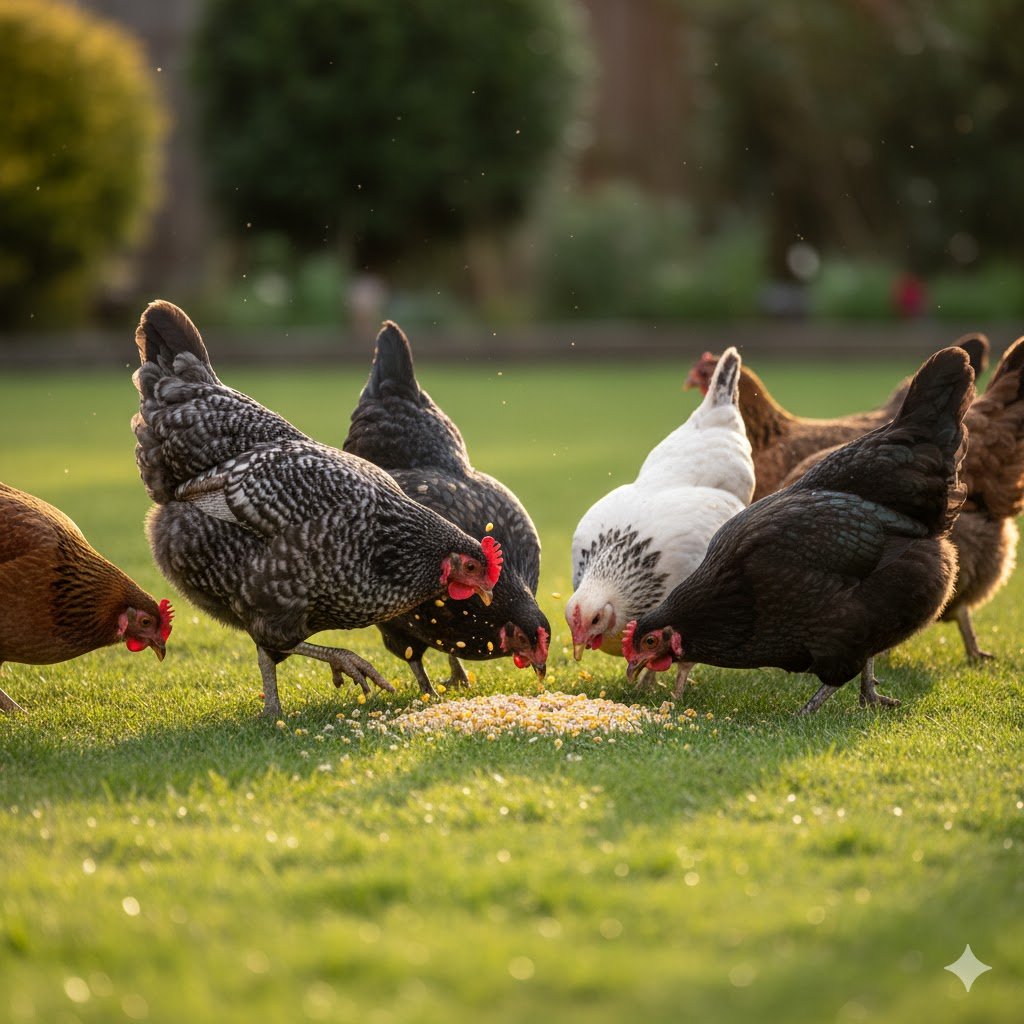
While the Small Holder Range is a sub-brand of Allen & Page, it has carved out its own distinct identity. It is specifically targeted at hobby keepers and smallholders who prioritise natural ingredients and ethical standards. All their feeds are approved by the Vegetarian Society, contain no artificial additives, and are designed to support free-range birds.
User & Forum Perspectives: This range is incredibly popular with keepers of rescued hens. Testimonials from volunteers at the British Hen Welfare Trust and other rescue organisations in 2025 frequently mention how Smallholder Layers Pellets help ex-battery hens to feather up and regain condition, as noted in the BHWT feeding your hens guide. Users love that it’s a “kind” feed, formulated without soya in many of its products.
The Smallholder Range Super Mixed Corn is also a standout favourite. Forum posts often describe it as a high-quality treat that the hens “go crazy for.” The consensus is that this range offers a fantastic middle ground: it has the natural, ethical credentials of a premium brand but is often slightly more affordable than the main Allen & Page organic line.
Key Products & Details:
- Smallholder Layers Pellets 20kg: A balanced, natural feed perfect for everyday use (around £18).
- Smallholder Range Super Mixed Corn: A treat mix of wheat, maize, peas, and grit (around £10 for 5kg). Remember, treats like this are like a biscuit for us—tasty, but should only make up about 10% of their diet.
Choosing a brand is a big step, but to truly become an expert, it helps to understand what you’re actually looking for on the feed bag label.
Beyond the Brand: How to Read a Feed Label and What to Look For
The labels on feed bags are packed with information. Here’s how to decode them:
- Crude Protein: This is the headline figure, but quality matters more than quantity. A good feed uses high-quality protein sources.
- Lysine and Methionine: These are essential amino acids. Look for them on the label as they are vital for feather production and egg development.
- Crude Fibre: Important for good digestion. A level of around 4-6% is typical.
- Vitamins and Minerals: A good layers feed will be fortified with vitamins A, D, and E, plus calcium and phosphorus for bone health and eggshells.
Beyond Pellets: Treats, Supplements, and UK Regulations
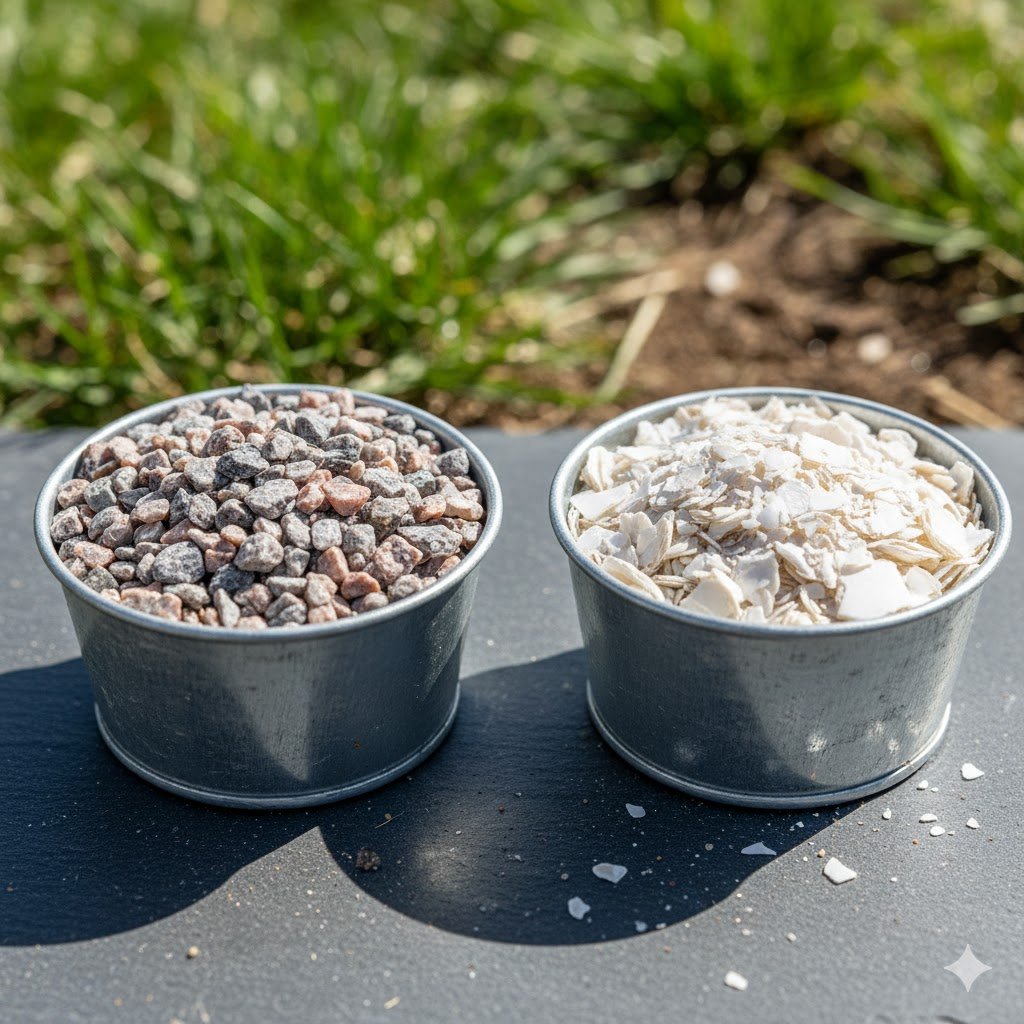
While pellets should be 90% of your flock’s diet, you can offer supplements and treats.
- Grit: Chickens don’t have teeth; they use small stones (grit) in their gizzard to grind up food. If your hens are free-ranging, they will find their own. If they’re in a run, you must provide a small pot of poultry grit.
- Oyster Shell: As mentioned, this provides extra calcium for laying hens. Always offer it in a separate container, not mixed into the feed. To dive deeper, learn more about grit and oyster shells for chickens.
- Safe Treats: A little mixed corn, sunflower seeds, mealworms (in moderation), and leafy greens like kale and cabbage are all great.
- UK Law on Kitchen Scraps: Remember, under longstanding DEFRA regulations (from 2001 and enforced in 2025), it is illegal to feed your chickens any kitchen scraps, even from vegan households, according to the DEFRA animal by-products rules. This helps prevent diseases like avian flu.¹ Safe treats include only approved ones like mealworms (live only, per DEFRA).
Even with the perfect feed and treats, feeding problems can still arise. Let’s tackle some of the most common issues UK keepers face.
Weekly Feed Audit Checklist for UK Chicken Owners
To keep your flock in peak condition, a quick weekly check of their feed and water setup is a great habit to get into.
- [ ] Check Feeders: Are they clean and dry? Remove any old, damp, or soiled feed immediately.
- [ ] Inspect Feed Quality: Look inside your storage bin. Is there any sign of mould, dampness, or pests? The feed should smell fresh and earthy.
- [ ] Monitor Consumption: Is the feed level going down as you’d expect? A sudden drop or increase in appetite can be an early sign of a health issue.
- [ ] Top Up Supplements: Check the levels of oyster shell and grit. Are they clean and freely available?
- [ ] Water Check: Is the water fresh and the drinker sparkling clean? Scrub drinkers weekly to prevent algae buildup.
- [ ] Observe Droppings: Healthy droppings are a good indicator of gut health. Look for firm, brown droppings with a white cap.
- [ ] Assess Eggshells: Are the shells strong and smooth? This is a direct reflection of their calcium intake.
Common Feeding Problems & Solutions for Backyard Flocks
- Problem: My hens won’t eat their new food! Solution: This is why a slow, 7-day transition is so important. If they are still being picky, try moistening the new pellets with a tiny amount of warm water to change the texture and release the aroma.
- Problem: I’m finding soft-shelled or shell-less eggs. Solution: This is almost always a sign of a calcium deficiency. Ensure you are feeding a quality layers pellet and, most importantly, provide a separate, free-choice supply of crushed oyster shell.
- Problem: How do I feed a mixed-age flock? Solution: This is a classic dilemma. You can’t feed high-calcium layers pellets to growing pullets. The best solution is to feed everyone growers pellets and provide oyster shell in a separate hopper. This allows the laying hens to get the extra calcium they need, while the younger birds will ignore it.
Conclusion
Choosing the right feed is one of the most important decisions you’ll make for your backyard flock. By understanding the difference between growers and layers pellets and getting to know the top UK brands, you’re well on your way to raising healthy, happy, and productive hens. A Guide to the Best UK Poultry Feed Brands (Allen & Page, BOCM, Small Holder Range) should give you the confidence to pick the perfect product for your birds.
For small flocks and those prioritising organic, natural ingredients, the ranges from Allen & Page and the Small Holder Range are outstanding. For those on a tighter budget or with more mouths to feed, BOCM offers a reliable and affordable alternative. These picks represent the best layers pellets UK 2025 and organic chicken feed UK options for backyard owners.
Now that you’re armed with this knowledge, you can make an informed choice for your feathered friends. Don’t forget, if you keep any poultry (even a few pets or under 50 birds), you must register your flock with APHA within one month according to the official DEFRA/APHA registration guide.² This gets you important updates on things like bird flu. Once you’re set up, you might even be interested in our guide to legally selling backyard chicken eggs. For more on your flock’s setup, check our related guides.
Why not start with a small bag of Allen and Page Layers Pellets 5kg and see the difference it makes? This guide is designed to help you feed your flock smartly and confidently in 2025 and beyond.
Disclaimer: This guide provides general advice. Always consult a UK-based vet for flock-specific health and nutrition advice.
Frequently Asked Questions (FAQs)
What Are Poultry Pellets?
Poultry pellets are a type of chicken feed where essential ingredients like grains, proteins, vitamins, and minerals are mixed and compressed into a small, pellet form. This ensures a balanced diet in every bite and reduces food waste from selective feeding.
What Are Growers Pellets For?
Growers pellets are a specific feed for young chickens (pullets) aged approximately 6 to 18 weeks. They contain 16-18% protein to support healthy growth and have low calcium levels to protect their developing kidneys before they start laying eggs.
Can Chickens Eat Too Much Grower Feed?
While chickens usually self-regulate their food intake, they can overeat grower feed, leading to obesity, especially if they are in a confined space. It’s best to monitor their condition and encourage foraging to prevent over-consumption.
What’s the Difference Between Growers Pellets and Layers Pellets?
The main differences are in protein and calcium levels. Growers pellets have higher protein (16-18%) and low calcium, designed for young, growing birds. Layers pellets have slightly lower protein (15-16%) and high calcium (3-4%), which is essential for strong eggshells in hens that are laying eggs.
What About Allen and Page Chick Crumb 20kg?
It’s a high-protein starter for 0-8 weeks, drug-free with prebiotics for gut health. Around £20, perfect for UK damp starts—mix with water if needed.
What’s Smallholder Range Super Mixed Corn?
It’s a tasty treat mix of wheat, maize, peas, and grit for UK chickens, around £10 for 5kg. Feed as an afternoon scratch (10% diet max) to encourage foraging and prevent boredom in gardens.

Oladepo Babatunde is the founder of ChickenStarter.com. He is a backyard chicken keeper and educator who specializes in helping beginners raise healthy flocks, particularly in warm climates. His expertise comes from years of hands-on experience building coops, treating common chicken ailments, and solving flock management issues. His own happy hens are a testament to his methods, laying 25-30 eggs weekly.
